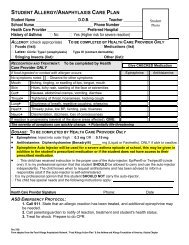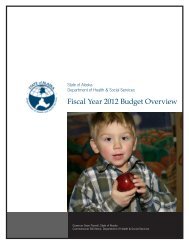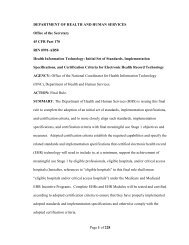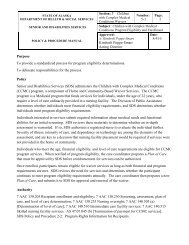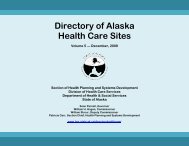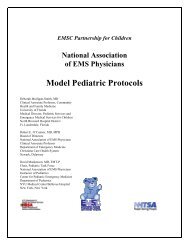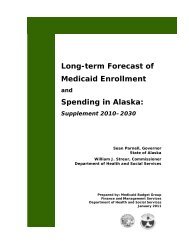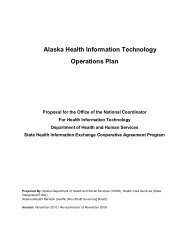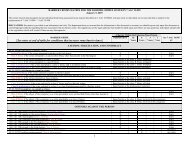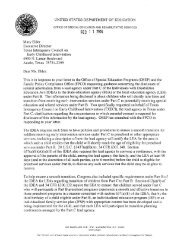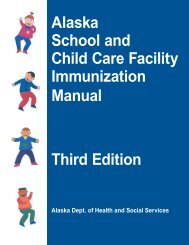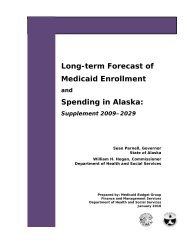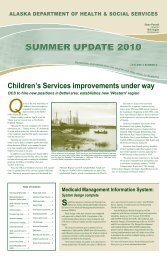Alaska Pioneer Homes Advisory Board Report - Fall 2009
Alaska Pioneer Homes Advisory Board Report - Fall 2009
Alaska Pioneer Homes Advisory Board Report - Fall 2009
You also want an ePaper? Increase the reach of your titles
YUMPU automatically turns print PDFs into web optimized ePapers that Google loves.
Department of Health &<br />
Social Services<br />
Division of <strong>Alaska</strong> <strong>Pioneer</strong><br />
<strong>Homes</strong><br />
PO Box 110690<br />
Juneau <strong>Alaska</strong> 99811-<br />
0690<br />
Phone (907) 465 4416<br />
Fax (907) 465-4108<br />
Visit the <strong>Pioneer</strong> <strong>Homes</strong><br />
Internet Website at:<br />
http://hss.state.ak.us/dalp/<br />
1<br />
<strong>Alaska</strong><br />
Veteran’s<br />
& <strong>Pioneer</strong><br />
<strong>Homes</strong><br />
REPORT TO THE<br />
PIONEER HOMES<br />
ADVISORY BOARD<br />
FALL <strong>2009</strong>
Pictures on the front cover (from top to bottom):<br />
1. Unidentified resident at the Anchorage<br />
<strong>Pioneer</strong> Home<br />
2. Artist Rie Munoz donated 25 of her prints<br />
to the Sitka <strong>Pioneer</strong>s’ Home. The home’s<br />
administrative team celebrated the gift<br />
with Munoz at a reception held in her<br />
honor, July 10, <strong>2009</strong>. From left: Klaudia<br />
Leccese, social services, Judi Blankenship,<br />
environmental services foreman, Rie<br />
Munoz, artist, Peter Kennedy,<br />
maintenance foreman, Shirley Downing,<br />
nurse manager and Philip Welsh,<br />
administrator. (Photo courtesy James<br />
Poulson/Daily Sitka Sentinel)<br />
3. Anna Hill at an Anchorage <strong>Pioneer</strong> Home<br />
luau. Anna in her youth was on the hit TV<br />
show "Hawaii Five-O"<br />
4. Juneau reunion, July <strong>2009</strong>- Relatives of<br />
Joseph Juneau, for whom the city of<br />
Juneau was named, recently celebrated<br />
their family reunion in the capital city, in<br />
conjunction with the celebration of<br />
<strong>Alaska</strong>’s 50th year as a state. The Juneaus<br />
graciously accepted an invitation to the<br />
<strong>Pioneer</strong>s’ Tea at the Juneau <strong>Pioneer</strong>s’<br />
Home. Pictured are: Kathleen Fanning,<br />
Activity Director, Virginia Juneau,<br />
(matriarch of the family), her son, John<br />
Juneau, resident Katherine Shaw, her son<br />
Al, and Harriet Botelho<br />
5. Palmer <strong>Pioneer</strong> Home Veteran Thelma<br />
Tomlinson at the Veteran’s Award<br />
Ceremony<br />
2
Table of Contents<br />
Mission Statement 4<br />
Overview<br />
Governance 5<br />
Consumers 5<br />
Services 5<br />
Initiatives from Central Office 7<br />
<strong>Alaska</strong> Veterans and <strong>Pioneer</strong>s Home 10<br />
Anchorage <strong>Pioneer</strong> Home 16<br />
Fairbanks <strong>Pioneer</strong> Home 21<br />
Juneau <strong>Pioneer</strong> Home 24<br />
Ketchikan <strong>Pioneer</strong> Home 28<br />
Sitka <strong>Pioneer</strong> Home 36<br />
3
Mission Statement<br />
The Mission of the <strong>Alaska</strong> <strong>Pioneer</strong> <strong>Homes</strong> is to assist older <strong>Alaska</strong>ns to<br />
have the highest quality of life by providing assisted living in a safe home<br />
setting which promotes positive relationships, meaningful activities and<br />
physical, emotional and spiritual growth.<br />
4
Governance<br />
The Division of <strong>Alaska</strong> <strong>Pioneer</strong> <strong>Homes</strong>, in the Department of<br />
Health and Social Services, manages the six <strong>Pioneer</strong>s’ <strong>Homes</strong>. The<br />
<strong>Alaska</strong> <strong>Pioneer</strong> <strong>Homes</strong> <strong>Advisory</strong> <strong>Board</strong> (<strong>Board</strong>) tours <strong>Homes</strong> every<br />
year in the fall and winter and makes recommendations to the<br />
Governor.<br />
The <strong>Pioneer</strong> <strong>Homes</strong> are licensed assisted living homes,(total?)<br />
operating in accordance with the statute and regulations<br />
pertaining to assisted living. They are managed on-site by<br />
administrators appointed by the Governor.<br />
There is a clear distinction between the management functions<br />
assigned to the division and the advisory function of the <strong>Board</strong>.<br />
The <strong>Board</strong> is the established link between citizens and<br />
policymakers, and as such provides community feedback to<br />
policymakers from the public. The <strong>Board</strong> gathers information and<br />
discusses issues at public meetings held during the annual <strong>Board</strong><br />
tour of the <strong>Pioneer</strong> <strong>Homes</strong>. From the information gathered at their<br />
meetings, the <strong>Board</strong> develops policy recommendations that are<br />
forwarded to the Governor.<br />
Consumers<br />
The average age of current <strong>Pioneer</strong> Home residents is 85.5 years.<br />
Two thirds of residents are female and about half of the residents<br />
suffer at least mild cognitive impairment. 45 percent of the<br />
residents are able to pay the full amount charged for their care,<br />
others pay a portion of the charges based on their income and<br />
assets, and funding from the division’s Payment Assistance<br />
Program or the Older <strong>Alaska</strong>n Medicaid waiver.<br />
Services<br />
In the spirit of resident directed care, <strong>Pioneer</strong> Home care teams<br />
involve a resident’s family, friends, and advocates in assessing and<br />
planning a resident’s service needs during the admission process<br />
and periodically thereafter. At the conclusion of the assessment, a<br />
service level is determined based on the resident’s needs and<br />
abilities. Services available to residents of the <strong>Homes</strong> may include:<br />
5
Meal preparation<br />
Emergency call systems/assistance<br />
Assistance with bathing, dressing, and eating<br />
Assistance with medications<br />
Health assessment<br />
Recreational opportunities<br />
Social work services<br />
Opportunities for spiritual worship<br />
Of the general types of available services listed above, certain<br />
services have been grouped into categories called service levels.<br />
There are three different service levels and each resident receives<br />
services within one particular level of care. Monthly charges are<br />
based on the service level of care. The three service levels available<br />
to residents of the <strong>Pioneer</strong> <strong>Homes</strong> are as follows:<br />
(1) Level I services include the provision of housing, meals,<br />
emergency assistance, and opportunities for recreation; level I<br />
services do not include staff assistance with activities of daily<br />
living, medication administration, or health-related services,<br />
although the pioneer home pharmacy may supply prescribed<br />
medications;<br />
(2) Level II services include<br />
(A) the provision of housing, meals, and emergency<br />
assistance; and<br />
(B) as stated in the resident’s assisted living plan, staff<br />
assistance, including assistance with activities of daily<br />
living, medication administration, recreation, and healthrelated<br />
services; assistance provided by a staff member<br />
includes supervision, reminders, and hands-on<br />
assistance, with the resident performing the majority of<br />
the effort. During the night shift, the resident is<br />
independent in performing activities of daily living and<br />
capable of self-supervision;<br />
6
(3) Level III services include<br />
(A) the provision of housing, meals, and emergency<br />
assistance; and<br />
(B) as stated in the resident’s assisted living plan, staff<br />
assistance, including extensive assistance with activities of<br />
daily living, medication administration, recreation, and<br />
health-related services; assistance provided by a staff<br />
member includes hands-on assistance, with the staff member<br />
performing the majority of the effort; the resident may receive<br />
assistance throughout a 24-hour day, including the provision<br />
of care in a transitional setting.<br />
The services within each service level are further tailored to meet<br />
individual residents’ needs. A service contract and assisted living<br />
plan are developed with each resident or resident representative.<br />
The assisted living plan is reviewed at regular intervals and<br />
modified to meet the changing needs of residents.<br />
Initiatives from Central Office<br />
Apprenticeship Program<br />
The <strong>Pioneer</strong> <strong>Homes</strong> recognizes the worth of employee retention. In<br />
order to increase employee retention for Certified Nursing<br />
Assistants (CNAs), one strategy the <strong>Pioneer</strong> <strong>Homes</strong> implemented<br />
has been an apprenticeship program. There have been 38 <strong>Pioneer</strong><br />
<strong>Homes</strong> CNAs who were enrolled in the Introduction to Dementia,<br />
40 students enrolled in Introduction to Geriatrics and 15 in the<br />
Mentor class.<br />
The <strong>Pioneer</strong> <strong>Homes</strong> Apprenticeship Program, which provides<br />
training for CNA’s within the PH system, works in collaboration<br />
with the University <strong>Alaska</strong> Anchorage Center for Human<br />
Development, the <strong>Alaska</strong> Department of Labor and One-Stop<br />
Employment Centers and the US Department of Labor <strong>Alaska</strong><br />
Office of Apprenticeship.<br />
7
The collaborative effort has already produced benefits in the form<br />
of increases in job performance and job satisfaction. We expect<br />
turnover rates to decrease with an increase in overall job<br />
satisfaction.<br />
Department of Administration Classification adjusted the CNAII<br />
class specifications in order for us to temporarily move CNAI to<br />
CNAII in order for us to be consistent with the apprenticeship<br />
program design. However, over the long run this temporary<br />
solution will need to be re-examined as more and more employees<br />
fulfill the apprenticeship requirements and are eligible for a reclass<br />
from CNAI to CNAII.<br />
The <strong>Pioneer</strong> <strong>Homes</strong> long-range goal is to establish the class<br />
specifications for apprenticeships for our CAN job series. We are<br />
still hopeful the division of personnel will work on establishing the<br />
class specifications for apprenticeships in order to enable us to<br />
continue with the apprenticeship program.<br />
Preparedness Planning<br />
In the spring of <strong>2009</strong> we were fortunate enough to receive from the<br />
State of <strong>Alaska</strong> Emergency Preparedness Program a grant of<br />
$30,000. We purchased Evacu-chairs (for evacuating residents<br />
down stairs) and Emergency radios that have the capability of<br />
transmitting state wide. Each home and one in central office will<br />
have a radio that will be registered with the <strong>Alaska</strong> land Mobile<br />
radio communications systems. This fall we have been awarded<br />
another $30,000 to purchase emergency preparedness equipment<br />
or training.<br />
Currently, all the homes are engaged in developing their Pandemic<br />
response plan, which is required to be submitted to the<br />
Department’s Emergency Preparedness Program.<br />
8
Safe Lifting Initiative<br />
This year the <strong>Pioneer</strong> <strong>Homes</strong> continued its involvement in the<br />
<strong>Pioneer</strong> Home Safe Lifting Initiative with consultant Michael Lary.<br />
This year Mr. Lary worked with the Ketchikan <strong>Pioneer</strong> Home<br />
training and introducing safe resident movement techniques and<br />
equipment.<br />
The <strong>Pioneer</strong> <strong>Homes</strong> spent a special amount of effort developing our<br />
Web site. If you have a chance please visit our new look at:<br />
http://www.hss.state.ak.us/dalp/<br />
Dashboards?<br />
What else??<br />
Infor Insights contract<br />
Replace the occupancy report and waitlist database with cutting edge webbased<br />
application<br />
Began capturing activity measure which shows how many resident need<br />
assistive with feeding, mobility, etc. this will be of great assistance when<br />
explaining the increase in the acuity of our residents<br />
9
<strong>Alaska</strong> Veterans and <strong>Pioneer</strong> Home<br />
October <strong>2009</strong><br />
Introduction<br />
Our <strong>Alaska</strong> Veterans and <strong>Pioneer</strong><br />
Home continues to strive to assist<br />
older <strong>Alaska</strong>ns to have the highest<br />
quality of life by providing assisted<br />
living in a safe home setting which<br />
promotes independence, positive<br />
relationships, meaningful activities<br />
and physical, emotional and<br />
spiritual growth.<br />
Our History<br />
The Palmer <strong>Pioneer</strong> Home was built<br />
in 1971 on the former site of the<br />
<strong>Alaska</strong> State Fairgrounds. Nestled<br />
in the heart of downtown Palmer,<br />
the home is surrounded by beautiful<br />
views of the Chugach and Talkeetna<br />
Mountain Ranges as well as the<br />
massive Knik Glacier.<br />
10<br />
<strong>Alaska</strong> Veteran’s & <strong>Pioneer</strong><br />
Home in Palmer, <strong>Alaska</strong><br />
In 1999 the home became registered as an official Eden<br />
Alternative home. The home’s casual country charm made for a<br />
seamless transition to the Eden Alternative approach to a home<br />
environment centered on the residents. Several resident<br />
neighborhoods complete with their own dining rooms and<br />
sitting/activity areas support the Eden philosophy.<br />
In May 2004 the <strong>Alaska</strong> legislature approved development of the<br />
state’s first veteran’s home. After extensive remodeling and program<br />
development to meet U.S. Department of Veterans Affairs (VA)<br />
requirements, the facility were renamed the <strong>Alaska</strong> Veteran’s and<br />
<strong>Pioneer</strong> Home. Seventy-five percent of the seventy nine beds in the<br />
home are designated for veterans, and twenty-five percent are<br />
available for non-veterans. Qualifying veterans are eligible for a perdiem<br />
from the VA to offset costs of their care.
<strong>Alaska</strong> Veterans and <strong>Pioneer</strong> Home<br />
October <strong>2009</strong><br />
Accomplishments<br />
In the past year there has been a resurgence of interest in our<br />
Resident Council. The council is led by Ed Willis who has served in<br />
both the <strong>Alaska</strong> Senate and House of Representatives. As<br />
advocates for seniors, members have actively participated in public<br />
hearings and partnered with community organizations in support of<br />
the home. They have been busy with projects large and small that<br />
not only benefits the recipients but also gives the residents a sense<br />
of self worth and adds meaning and purpose to their lives.<br />
Ed Willis with his Potato<br />
harvest<br />
The council played an active role in the<br />
planning and development of a<br />
community wheelchair accessible<br />
garden. The project was a collaborative<br />
effort between the Home and the<br />
University of <strong>Alaska</strong> Mat – Su College<br />
students and professors. Funding was<br />
provided by an organization called Learn<br />
& Serve in America. Residents already<br />
garden in small sites throughout the<br />
grounds. And with the new garden it will<br />
increase the bountiful harvest of herbs<br />
and vegetables that residents will be able<br />
to produce.<br />
We have enjoyed wonderful soups,<br />
homemade sauerkraut, breads, and jellies that residents and staff<br />
have made from the bounty. The opening celebration ended with a<br />
lecture in organic gardening from one of the professors at Mat-Su<br />
College. The gardening projects are a great source of joy and pride<br />
for this farming community.<br />
Other resident council projects include the purchase of fleece<br />
wheelchair arm covers to give an added measure of comfort to those<br />
confined to wheelchairs.<br />
They also showed support of the volunteer Mat-Su Valley recycling<br />
project by stuffing envelopes for mass mail outs.<br />
11
<strong>Alaska</strong> Veterans and <strong>Pioneer</strong> Home<br />
October <strong>2009</strong><br />
The Mat-Su community is so<br />
supportive of the Home that we are<br />
always grateful to be able to give<br />
back. This year staff and residents<br />
collected food for victims of spring<br />
flooding of the Yukon River. We<br />
also partnered with local veterans<br />
groups to provide food, clothing<br />
and blankets to impoverished<br />
veterans in remote areas of the<br />
state. A community wide<br />
collection was sponsored by Mat-<br />
Su Veterans Council and the<br />
Veterans Aviation Outreach made<br />
drops to remote sites.<br />
The community looks to us as a<br />
center for veterans and active<br />
12<br />
Barney Furman & Director,<br />
Dave Cote<br />
military support, outreach and celebration. As such, we honor and<br />
commemorate service men and women throughout the year. On<br />
Veteran’s Day we host a special event attended by active military<br />
personnel, their families, and veterans in the community. On<br />
Memorial Day, residents are transported to ceremonies at the<br />
Veterans Memorial Wall and to lunch at one of the local veteran’s<br />
organization posts. In addition a moment of remembrance for the<br />
fallen is held at a designated time at our home and all the veterans’<br />
homes across the nation.<br />
Our veterans also joined federal, state and community dignitaries in<br />
the grand opening ceremonies for the new VA community based<br />
outpatient clinic in Wasilla. One of our veterans opened the<br />
program with an invocation and another participated in the ribbon<br />
cutting.<br />
At a separate, very reverent ceremony at the Home twenty three of<br />
our veterans were recognized for their service with a presentation of<br />
the <strong>Alaska</strong> Veterans Service Medal.
<strong>Alaska</strong> Veterans and <strong>Pioneer</strong> Home<br />
October <strong>2009</strong><br />
Level 3 residents continue to make up the largest group in the<br />
home. Over the past 12 months Level 3 residents have averaged<br />
72.4% of our census. Acuity within that group continues to<br />
increase and is measured on an ongoing basis to determine how we<br />
can best serve their needs. Safety is a high priority with such a<br />
fragile group. Two small offices were combined into a larger nurse’s<br />
station to allow the staff to be closer to the residents with the<br />
highest needs. The nurse call system was upgraded and all door<br />
alarms, resident calls and fall risk monitor systems are dispatched<br />
directly to the care team’s pagers.<br />
Current installation of security cameras will provide another<br />
measure of safety and security for staff and residents alike. They<br />
will be located in all hallways, parking lots, entry ways, and<br />
common areas throughout the building.<br />
Additional projects funded in FY 09 include coax cable replacement,<br />
a generator transfer switch upgrade, and replacement of the metal<br />
trim or flashing outside the building.<br />
Lovely Helen Jackson adorns<br />
herself with flowers from the<br />
garden<br />
Challenges<br />
Despite technical advances, hands on care<br />
are the greatest need this population<br />
requires. We continue to be challenged<br />
with the high cost of providing that care.<br />
A subset of the Level 3 population<br />
challenges us with advancing Alzheimer’s<br />
that leads to behavior that is sometimes<br />
difficult to control. Amongst those there<br />
also exist a number of residents who had<br />
mental health concerns earlier in life that<br />
are now resurfacing.<br />
Residential elder care within <strong>Alaska</strong>, for<br />
those with behavioral and mental health<br />
concerns, is virtually nonexistent.<br />
13
<strong>Alaska</strong> Veterans and <strong>Pioneer</strong> Home<br />
October <strong>2009</strong><br />
A facility that houses residents for a short stay while medication<br />
trials for behavior management are completed would provide a safe<br />
temporary transition and allow the resident to return home to<br />
AVPH.<br />
As with all of us, our population is aging and acute illnesses are<br />
bound to occur. Technological advances in healthcare allow<br />
patients to live longer with the support of new devices and<br />
equipment. Hospital stays have grown shorter since the Medicare<br />
DRG reimbursement system was implemented. This poses yet<br />
another challenge for us; when hospitals discharge sooner our<br />
Home must be prepared for residents re-entering the home with<br />
higher acuity and medical needs. New equipment and higher<br />
acuities require additional training and nursing time to manage.<br />
The line becomes blurred between skilled care and assisted living.<br />
Every level of healthcare has seen an increase in acuities. Skilled<br />
care facilities now manage patients that used to be cared for in<br />
hospitals. As profit margins have shrunk, fewer providers are<br />
willing to accept Medicare patients. This problem is universal<br />
throughout the country; however <strong>Alaska</strong> has a very limited number<br />
of skilled nursing beds and Medicare providers. We are simply<br />
experiencing this challenge as part of the bigger healthcare problem<br />
in the country.<br />
This year we were audited by Assisted Living Licensing, US<br />
Department of Veterans Affairs, US Department of Labor, and<br />
Medicaid. Although all audits acknowledge that we are providing<br />
excellent care, the need for documentation of all our services has<br />
increased. This places a huge burden on all staff and takes time<br />
away from the resident.<br />
Our building also continues to age and feels as though it is bulging<br />
at the seams. VA inspections have resulted in additional space<br />
requirements for utility rooms. The few existing closets that were<br />
left have been remodeled to meet compliance requirements.<br />
Although there were extensive heating and ventilation upgrades<br />
with the VA construction project, certain areas of the home<br />
continue to have very poor ventilation.<br />
14
<strong>Alaska</strong> Veterans and <strong>Pioneer</strong> Home<br />
October <strong>2009</strong><br />
One such area is the pharmacy closet in the Nursing Resource<br />
Center. Temperatures in that area have been above what is<br />
considered safe for medication storage. It is our hope that capital<br />
funding will be approved to remodel the Nursing Resource Center to<br />
better suit the current needs of the home and its residents while<br />
meeting regulatory requirements and standards of care.<br />
Veteran’s beds filled- % etc add.<br />
15<br />
Ed Walker at the VA CBOC<br />
opening ceremony
Anchorage <strong>Pioneer</strong> Home<br />
October <strong>2009</strong><br />
Introduction<br />
The Anchorage <strong>Pioneer</strong><br />
home sits like a jewel in the<br />
crown of this historical<br />
community core. The<br />
building was constructed<br />
in stages beginning with<br />
the five story tower in 1977<br />
and completed in 1982. As<br />
would be expected in any<br />
facility after 30 years of<br />
service, particularly one<br />
that involves hundreds of<br />
staff serving 168 <strong>Alaska</strong>n<br />
Elders, there are many maintenance challenges.<br />
16<br />
APH Resident Nancy Culp with CNA<br />
Ron Watkins<br />
The Anchorage <strong>Pioneer</strong> Home provides licensed assisted living<br />
care for <strong>Alaska</strong> resident elders sixty-five years old or older. The<br />
home has a capacity for 168 elders and provides care at three<br />
different levels including care for persons with Alzheimer’s<br />
disease or related dementia (ADRD).<br />
Our History<br />
The Elders of the Anchorage home include many of the great<br />
pioneers of the first half of the 20th century including<br />
homesteaders, miners, authors, bush pilots, and families who<br />
turned Anchorage from a railroad tent town to <strong>Alaska</strong>’s center of<br />
commerce and culture. Even an ex-television star resides in the<br />
Home. The Anchorage <strong>Pioneer</strong>s’ Home serves elders ranging in<br />
age from mid-60’s to 100. In 2000 the home became registered<br />
as an Eden Alternative home. The goal of this program is to<br />
overcome the three issues that elders in long term care face:<br />
loneliness, helplessness and boredom. This is done by creating a<br />
natural home environment where elders, caregivers, support<br />
staff, family members, friends and volunteers all participate in<br />
elder-centered care.
Anchorage <strong>Pioneer</strong> Home<br />
October <strong>2009</strong><br />
We’ve worked very hard to make the Anchorage <strong>Pioneer</strong> Home a<br />
hub of activity within the downtown community. With our<br />
prime location right next to the Park Strip and our beautiful<br />
grounds covered in flowers in the summer and sparkling white<br />
lights in the winter, the home is an attraction for visitors and<br />
neighbors. The home is an important component of the local<br />
community and hosts not only activities which are fun for the<br />
whole family such as concerts and parties but also business<br />
meetings such as Community Council and local homeowners<br />
associations. (no mention of the apprenticeship program)<br />
Accomplishments<br />
In recent months the<br />
Anchorage home has<br />
been a busy<br />
construction zone<br />
which has resulted in<br />
substantial<br />
improvements to the<br />
home and also<br />
provided a good deal<br />
of stimulation and<br />
entertainment for our<br />
elders. This past<br />
winter old tile flooring<br />
was replaced in all the<br />
dining rooms as well<br />
APH Resident Joe Smart with Tamaro Lewis<br />
on St Patrick’s Day<br />
as the entire 2 north neighborhood with beautiful rolled vinyl<br />
wood-grain flooring. This was a huge project with a lot of<br />
disruption to the home but we made it fun by having 6 residents<br />
at a time “go camping” in another area of the home while their<br />
floors were being replaced. Glass in the windows in the south<br />
tower was also replaced as the old ones had broken seals and<br />
had become inefficient. Our stand alone generator for the home<br />
was also replaced as the old one was not up to code.<br />
17
Anchorage <strong>Pioneer</strong> Home<br />
October <strong>2009</strong><br />
As you can tell, APH has been a very busy place this past year!<br />
These capital improvements have been wonderful for the home,<br />
but the real challenge is the everyday needs of the physical plant<br />
and the maintenance of the vast array of equipment. Our<br />
maintenance staff is overloaded with responsibility and is unable<br />
to keep up on important preventive maintenance issues as well<br />
as routine maintenance needs. Their time and talents are spent<br />
on important life safety issues that take priority. APH has a real<br />
need for more maintenance staff due to the age and condition of<br />
the building as well as the increase in maintaining equipment<br />
necessary for the care of the elders we serve.<br />
Challenges<br />
The APH staff feels very<br />
strongly that we are stewards<br />
of the Home and the Home<br />
belongs to the people of<br />
<strong>Alaska</strong>. As stewards we<br />
strive to keep the home at full<br />
capacity in order to meet the<br />
needs of as many elders we<br />
can in a safe environment.<br />
Year round, our occupancy<br />
remains at close to 100% and<br />
only dips briefly during the<br />
process of admission.<br />
18<br />
APH Resident Mable Didrickson with<br />
RN Amy Ryan-Ebert<br />
A challenge in this area is the trend toward elders with higher<br />
medical needs which leads to a decrease in length of stay; this in<br />
turn translates into a sharp increase in the number of<br />
admissions each year of residents at higher ages and medical<br />
acuity. Each admission represents a spike in the work load for<br />
the staff of the home. (This spike is from the direct care staff<br />
assessing and preparing the new resident, the maintenance and<br />
housekeeping crews preparing the resident room, and the<br />
admission staff gathering all the necessary documentation.)<br />
We have also found that (on average) we perform admission<br />
screenings/assessments on five individuals for each one person
Anchorage <strong>Pioneer</strong> Home<br />
October <strong>2009</strong><br />
admitted to the home. This process requires a great deal of manhours.<br />
As an example, APH has admitted 250 new residents in<br />
the past five years. In the five years before that less than half<br />
that number of residents, 115, was admitted.<br />
In addition to the challenge of numerous admissions and<br />
overwhelming maintenance needs, our home faces a<br />
documentation challenge brought on by Medicare and Medicaid<br />
requirements. The <strong>Pioneer</strong> Home has always maintained the<br />
standards of a top notch assisted living facility that charts “by<br />
exception”.<br />
APH Resident Anna Hill on Picnic<br />
Outing<br />
19<br />
This means that, unlike<br />
nursing homes and<br />
hospitals, we only chart on a<br />
resident if something<br />
unusual occurs. New<br />
standards require our<br />
nursing and activity staff<br />
document at a similar level<br />
as hospital documentation.<br />
These additional<br />
documentation requirements<br />
will result in less elder<br />
contact and less care unless<br />
we are able to increase our<br />
clerical staffing. Non<br />
compliance with the documentation requirements may result in<br />
interruption of revenue streams as well as monetary fines. As<br />
you can see, there is no choice when it comes to this<br />
documentation.<br />
The good news is that the elders who live in the Anchorage<br />
<strong>Pioneer</strong> Home receive tremendous first rate care in a safe and<br />
loving environment from staff that is highly qualified<br />
professionals. We are flattered that when there was a need in<br />
our community to assist another facility that had fallen below<br />
professional standards, the staff of the Anchorage <strong>Pioneer</strong> Home<br />
was called in to assist.
Anchorage <strong>Pioneer</strong> Home<br />
October <strong>2009</strong><br />
We are proud that APH is a teaching facility with a continual<br />
flow of students from local and out of state universities.<br />
APH has an ongoing in-house education program that allows our<br />
staff to stay on the cutting edge of their professions and advance<br />
in their chosen career.APH<br />
enjoys a great reputation in<br />
our community, among our<br />
elders and their families. We<br />
are excited that our<br />
volunteer program brings<br />
literally hundreds of<br />
volunteers into the home<br />
each month. But most of all<br />
we are honored and proud to<br />
be a part of the lives of the<br />
elders we serve.<br />
20<br />
APH Resident Elsie Hrubes at baking<br />
activity
Fairbanks <strong>Pioneer</strong> Home<br />
October <strong>2009</strong><br />
Introduction<br />
The Fairbanks <strong>Pioneer</strong><br />
Home was built in the<br />
Golden Heart City 42 years<br />
ago; it opened in July of<br />
1967. It then flooded in<br />
August requiring all of the<br />
residents to move to<br />
University Hill to wait it out.<br />
When the clean up was<br />
done, they moved back in<br />
and were on to living and<br />
enjoying life here at the home.<br />
21<br />
FPH Sing-A-Long in the Library<br />
The Fairbanks <strong>Pioneer</strong> Home is<br />
a warm and active community that provides exceptional care<br />
to those who live here. There are three distinct neighborhoods<br />
that meet the varying needs of our residents. At present the<br />
Fairbanks Home’s average age is 88, with 4 individuals over<br />
the age of 100.<br />
Accomplishments<br />
The Home continues to participate with the Fairbanks Senior<br />
Services providers group. We meet on a regular basis with<br />
others in the community that shares the same interests.<br />
Our home now has a wonderful renovation to the Aurora<br />
neighborhood which was completed in a timely manner. It<br />
was a much needed face lift that was celebrated with our staff,<br />
residents and their<br />
families, gathering for a<br />
potluck and tours of the<br />
new Aurora neighborhood.<br />
Vickie Wilson, FPH<br />
Administrator, Carl<br />
Heflinger & Janet Perrigo<br />
at FPH annual Golden<br />
Days Family Reunion<br />
Picnic
Fairbanks <strong>Pioneer</strong> Home<br />
October <strong>2009</strong><br />
The Fairbanks <strong>Pioneer</strong> Home has worked successfully with the<br />
Tanana Valley Campus as a training sight for the Certified<br />
Nurse’s Aide program. This experience has provided our Home<br />
with a greater amount of Certified Nurse’s Aide applicants to<br />
choose from. Several staff of our staff participated in the<br />
University of Anchorage Distant Courses that is being offered<br />
as part of the Apprentice Program. The employees found the<br />
classes’ to be very beneficial.<br />
The Fairbanks <strong>Pioneer</strong> Home Foundation has been<br />
instrumental in fund raising to improve the walkways for our<br />
residents. The residents enjoy the improvements allowing<br />
them to walk further for daily exercise. The Foundation is<br />
planning on continued improvements this summer. We were<br />
pleased with the time we have gotten to spend with four of our<br />
residents over the age of 100, two of whom actively shared in<br />
our lives. It was a great privilege. Our Home has partnered<br />
with the local Alzheimer’s Association to share the talents of<br />
artists with our residents’ in the varying stages of dementia.<br />
The Fairbanks <strong>Pioneer</strong> Home installed Cameras in the facility<br />
to provide 24 hour building security<br />
22<br />
The FPH 6th Annual<br />
<strong>Pioneer</strong> Treasure Sale was<br />
a huge success again this<br />
year, netting in one day<br />
$10,000.00.
Challenges<br />
Fairbanks <strong>Pioneer</strong> Home<br />
October <strong>2009</strong><br />
This year has been a continuous struggle searching for<br />
Nurses. We have been unable to find RN’s, but have hired a<br />
group of LPN’s.<br />
Another challenge has been in finding RN’s that are equally<br />
skilled in supervising employees. We are in the process of<br />
reclassifying a position to be a Health Program Manager.<br />
This new position will help open up the field to those that<br />
specialize in Health Care combined with Personnel<br />
Management.<br />
With the diverse group of employees we have at the 24 hour<br />
facility there are continuing personnel issues. There is an<br />
incredible amount of time and energy spent resolving these<br />
issues, to strive for a more harmonious atmosphere.<br />
Further, our state personnel system challenges our ability<br />
to address those issues.<br />
23<br />
Marge Dirkz & Jessica<br />
Armstrong at the FPH<br />
Golden Days Family<br />
Reunion Picnic on July<br />
23, 2209
Juneau <strong>Pioneer</strong> Home<br />
October <strong>2009</strong><br />
Introduction<br />
The Juneau <strong>Pioneer</strong> Home<br />
was completed in 1988 and<br />
is currently home to 45<br />
incredible <strong>Alaska</strong>ns. The<br />
Home is nestled in the<br />
wetlands along Juneau’s<br />
Egan Drive and has<br />
breathtaking views of nearby<br />
mountains and the<br />
Gastineau Channel that<br />
divides the mainland from<br />
Douglas Island. .<br />
The home is divided into<br />
four neighborhoods that<br />
serve as mini-communities.<br />
Each community is<br />
supported by a team made<br />
up of residents, caregivers, support staff, family members,<br />
friends and volunteers. The team members sustain each other<br />
and individuals are encouraged to be creative in the<br />
development of a caring, loving home. The neighborhood<br />
concept is instrumental in building an atmosphere where<br />
loved ones who have dementia can feel safe and appreciated.<br />
24<br />
JPH residents Nina Brown and Stina<br />
Barrens, with staff Demy Carandang and<br />
Fred Abad, show off the beautiful flowers<br />
they grew this summer in sunny Juneau.<br />
In 1998 the Juneau <strong>Pioneer</strong> Home embraced the Eden<br />
Alternative® philosophy. TheJuneau <strong>Pioneer</strong> Home promotes<br />
the Eden Alternative. Within the Eden philosophy, family,<br />
friends, pets, and plants all contribute to creating a “human<br />
habitat” by revitalizing relationships and encouraging<br />
residents to be involved in a vibrant community. Central to<br />
the Eden philosophy is that decisions are made by teams<br />
which are comprised of the people closest to the residents.<br />
The team members sustain each other and are committed to<br />
providing compassionate care to residents in a manner that<br />
nurtures the human body, mind and spirit while preserving<br />
the dignity and individuality of residents.
Juneau <strong>Pioneer</strong> Home<br />
October <strong>2009</strong><br />
Accomplishments<br />
The Juneau <strong>Pioneer</strong> Home partnered with UAA to conduct a<br />
pilot project to develop the first Eden Alternative university<br />
course. This course resulted in 13 staff and 4 elders<br />
becoming Certified Eden Associates.<br />
25<br />
Sig Olsen dances with<br />
Marritt Andruss, the<br />
geriatric nurse<br />
practitioner at the<br />
Juneau <strong>Pioneer</strong> Home,.<br />
The Juneau <strong>Pioneer</strong><br />
Home celebrated its 20th<br />
anniversary ball with<br />
dancing, food and live<br />
music from the Thunder<br />
Mountain Big Band.<br />
JPH also continued to work with UAA on the apprenticeship<br />
program, resulting in two CNA mentors for our home<br />
We started a JPH Fitness Club as a motivational tool for<br />
residents. The physical therapy aides punch a card to<br />
indicate participation in an exercise session and when a<br />
card is filled up, residents get to choose a gift.<br />
We enrolled in the state’s VacTrak program to track<br />
residents’ vaccination history.<br />
JPH is once again certified as an OSHA SHARP site. This is<br />
an exemplary recognition of our health and safety record by<br />
the Occupational Safety and Health Association. We were<br />
the first state agency to receive this recognition two years<br />
ago, and have qualified for continuation as a SHARP site<br />
this year.<br />
Our partnership with the Tlingit and Haida Central Council<br />
Head Start program continues with exciting activities and<br />
relationships between the elders and the children.
Juneau <strong>Pioneer</strong> Home<br />
October <strong>2009</strong><br />
One special program, entitled<br />
“Reader Buddies”, has the<br />
elders reading children’s book<br />
to the kids.<br />
Our fire alarm system was<br />
upgraded to install a fully<br />
addressable system that<br />
indicates the exact location of<br />
the source of the problem.<br />
This project also replaced all<br />
our smoke detectors, heat<br />
detectors and pull stations.<br />
The JPH foundation provided<br />
scholarships for two Assisted<br />
26<br />
<strong>Pioneer</strong> Home <strong>Board</strong> Member,<br />
Martha Penrose and JPH resident<br />
Stina Barrans<br />
Living Aides to go to Certified Nursing Assistant School.<br />
We conducted satisfaction surveys with staff, residents, and<br />
elders and the results were excellent.<br />
We reactivated our greenhouse and grew a few vegetables<br />
and flowers. Residents were actively involved in our flower<br />
gardens in the back of the home where they grew 12 inch in<br />
diameter Dinner Plate Dahlias.<br />
Two staff from the Eden Alternative office came to JPH and<br />
made a videotape of our home. They interviewed several<br />
residents and staff about how they feel the Eden approach<br />
affects life in the home. This video will be part of a<br />
presentation at the Eden Alternative International<br />
Conference in Denver in June.<br />
All of the lighting fixtures in the home were replaced,<br />
resulting in increased efficiency in energy usage.<br />
Several JPH residents<br />
enjoyed our outdoor<br />
picnics during our long<br />
stretch of summer<br />
sunshine in Juneau.
Juneau <strong>Pioneer</strong> Home<br />
October <strong>2009</strong><br />
Challenges<br />
We continue to be challenged by our inability to attract on<br />
call nurses and Certified Nursing Assistants. Our on call<br />
pay is simply not competitive with other local health care<br />
entities. For several years, we have encouraged the<br />
University of <strong>Alaska</strong> Southeast to add another CNA class,<br />
and they finally did so this semester.<br />
We continue to hire on call Assisted Living Aides (ALA)<br />
because of the lack of CNA’s. The ALA staff comes to our<br />
Home with very little training or experience and it is<br />
incumbent on us to train in the basic skills, resulting in<br />
increased on call costs during the training period.<br />
We are experiencing an increase in the number and<br />
frequency of deaths, which is difficult for staff emotionally,<br />
and also results in increased workloads with more new<br />
admissions.<br />
Good bye Merritt!!<br />
27<br />
Millie Tandy, presenting<br />
flowers to Merritt<br />
Andruss, Prom Queen,<br />
and retiring JPH Nurse<br />
Practitioner extraordinaire
Introduction:<br />
The Ketchikan <strong>Pioneer</strong> Home<br />
(KPH) is licensed to care for 47<br />
assisted living residents. The<br />
Home is situated on a garden<br />
hillside that neighbors Alder<br />
Park, Sea View Terrace, the<br />
<strong>Alaska</strong> Marine Highway Ferry<br />
Terminal and the Inter-Island<br />
Ferry. Resident rooms are<br />
located on the two upper floors<br />
of the three-story building and<br />
are divided into neighborhoods<br />
based on resident level of care.<br />
The average daily census is 41<br />
and the average resident age is<br />
85.<br />
Ketchikan <strong>Pioneer</strong> Home<br />
October <strong>2009</strong><br />
28<br />
KH resident Audrey Glaser rides in the<br />
brand new KPH van during the Ketchikan<br />
Fourth of July parade.<br />
KPH is proud to offer a Respite Program, which allows applicants on the<br />
waitlist to stay for 14 days while their primary caregiver receives medical<br />
treatment and/or much needed rest. This essential program is the only<br />
one in our community and is critical to many of our frail, elderly friends.<br />
Another point of pride for our staff and residents is the Ketchikan<br />
Gateway Borough Fawn Mountain Elementary Indian Education<br />
Preschool program. This preschool is housed on the 2 nd floor and fills<br />
our halls with the laughter of children.<br />
Accomplishments (no mention of the no-lift training or<br />
apprenticeships)<br />
Our commitment to resident centered care is demonstrated in the<br />
following ways:<br />
A new rear loading wheelchair van has been a welcome addition for<br />
the residents this year as it is a much safer and easier solution for<br />
transporting residents.<br />
We have placed an emphasis on wellness with an increase in<br />
activities geared toward the resident’s spiritual and physical wellbeing.
Ketchikan <strong>Pioneer</strong> Home<br />
October <strong>2009</strong><br />
We proudly offer church services, gospel singing, outdoor walking<br />
clubs, swim therapy through the Arthritis Foundation, a specialized<br />
exercise class and a restorative aide program that has become vital<br />
to the residents. This increase in physical activities along with<br />
monthly massage therapy and spa days leads to a stronger and<br />
more balanced elder.<br />
We continue to remain committed to improving our process of<br />
Assisted Living Plan meetings so that all disciplines are able to<br />
contribute to the care plan process as well as the resident and<br />
residents loved ones. We have also maintained improvement in our<br />
resident charts and recent OSHA and Assisted Living Licensing<br />
audits indicated zero orders of correction. Additionally the KPH has<br />
the added responsibility of charting through Peace Health’s<br />
electronic medical record system which provides better continuity of<br />
care for the resident and improved communication with local<br />
medical professionals. When KPH residents arrive at the emergency<br />
room there is an updated medication list available to the physician<br />
through this database.<br />
KPH resident Harley Hall and a<br />
KPH preschool student enjoy a<br />
goodbye hug after school one<br />
day<br />
Our commitment to improving the physical structure is demonstrated in<br />
the following ways:<br />
The exterior painting and window replacement project is underway.<br />
This project will include a complete painting/staining of the exterior,<br />
removal and replacement of the sky bridge, exterior lighting upgrade<br />
and complete removal replacement of exterior windows and doors.<br />
<strong>Alaska</strong> Commercial Contractors of Juneau has been managing the<br />
29
Ketchikan <strong>Pioneer</strong> Home<br />
October <strong>2009</strong><br />
project with several subcontractors on site, substantial completion is<br />
scheduled for mid-October.<br />
The resident kitchen/activity area was completely renovated this year<br />
with new cabinets and counter space.<br />
30<br />
KPH resident Virgene<br />
Harvey (seated) looks on as<br />
volunteer and friend, Mary<br />
Hastings, helps to plant<br />
Marigolds during the annual<br />
hanging basket party on the<br />
KPH roof deck.<br />
Our commitment to fiscal responsibility is demonstrated in the following<br />
ways:<br />
Grant funding has been sought and obtained from the Rasmuson<br />
Foundation and BP Oil. Private funding has been obtained through<br />
the KPH Foundation, private donors, and local businesses.<br />
The Rasmuson Foundation has provided a wheelchair accessible<br />
custom computer desk and we have accepted a donation of a<br />
computer for the new resident media station located on the third floor.<br />
This will allow residents a greater opportunity to network and socialize<br />
with loved ones despite limited mobility. Recent studies indicate that<br />
improved socialization through the internet decreases loneliness and<br />
depression among seniors.<br />
Our commitment to collaboration in the community is demonstrated<br />
through membership and partnership with many local agencies some of<br />
which include: Ketchikan General Hospital, Ketchikan Indian<br />
Corporation, Rendezvous, Senior Services, Community Connections,<br />
Kayhi Community Service Club and Rotary.
Ketchikan <strong>Pioneer</strong> Home<br />
October <strong>2009</strong><br />
Our commitment to intergenerational activities is demonstrated through<br />
the continuation of the preschool on site as well as regular visits from<br />
many other committed volunteers in our community who have<br />
established relationships with our residents. Since we began our<br />
emphasis on intergenerational activities many years ago, our first young<br />
volunteers are now returning to us as teenagers and spending time with<br />
the residents at activities such as the pre-prom party where we host 75+<br />
teenagers for appetizers and a photo opportunity with the residents<br />
before prom.<br />
Our commitment to creative solutions is demonstrated in the following<br />
ways:<br />
The KPH Foundation has been offering C.N.A scholarships in<br />
exchange for work agreements to the KPH. This has enhanced our<br />
ability to capture the best of the C.N.A class and hire these students<br />
before they go out into the community and seek work elsewhere and<br />
we are no longer scrambling to recruit staff.<br />
The Gerontology Institute through Sacred Heart Medical Center in<br />
Eugene, Oregon is now a resource to KPH residents through the<br />
telemedicine project. A number of KPH residents are now receiving<br />
geriatric assessments and treatment for issues such as change in<br />
mental status, mood or behavior changes, multiple medication<br />
interactions, and gait and balance disorders.<br />
The residents requested more fresh fish and the community along with<br />
Nana Management Services responded.<br />
Through donations of locally processed fish, the residents have had<br />
hundreds of pounds of fresh salmon and halibut donated and they<br />
recently celebrated Grandparents Day with donations of Dungeness<br />
and King crab along with shrimp and smoked salmon.<br />
The Home for the Holidays program was recently honored by the<br />
Chamber of Commerce for using volunteers to safely transport<br />
residents of the KPH to their loved ones homes for the holidays.<br />
Challenges<br />
The Tongass bathing area and bathroom is in need of an extensive<br />
remodel and the Fireweed dining area is in need of a remodel to<br />
increase dining and living space.<br />
Storage for equipment is a critical need in every neighborhood.<br />
There is not currently an effective way to handle aggressive<br />
residents who become evicted from the <strong>Pioneer</strong> Home system.<br />
31
Ketchikan <strong>Pioneer</strong> Home<br />
October <strong>2009</strong><br />
Additional training has been requested for staff including Palliative<br />
Care training and training on working with aggressive residents.<br />
Ketchikan has so many pictures that they put in their newsletter how<br />
come they didn’t send some of them?<br />
32
Sitka <strong>Pioneer</strong> Home<br />
October <strong>2009</strong><br />
Introduction<br />
From the original “<strong>Report</strong> of<br />
the <strong>Board</strong> of Trustees and<br />
Superintendent of the <strong>Alaska</strong><br />
<strong>Pioneer</strong>s’ Home”: “Under the<br />
act of the First <strong>Alaska</strong><br />
Legislature, approved April<br />
30, 1913, the Hon. J.F.A.<br />
Strong, as Governor of <strong>Alaska</strong>,<br />
appointed Mr. W.P. Mills, of<br />
Sitka, <strong>Alaska</strong>, Treasurer of<br />
the <strong>Board</strong> of Trustees of the<br />
<strong>Alaska</strong> <strong>Pioneer</strong>s’ Home and<br />
Rev. S. G. Kostromentinoff, of<br />
Sitka, <strong>Alaska</strong>, Secretary of the<br />
<strong>Board</strong>, with the Governor as<br />
ex-officio President.” The<br />
<strong>Board</strong> met for the first time on<br />
July 4, 1913 and appointed<br />
A.G. Shoup as the Superintendent. These were the individuals whose<br />
vision and leadership created what some have described as the most<br />
progressive and effective eldercare model in the United States.<br />
33<br />
Iris Klingler with George and Freddi Young<br />
during the SPH <strong>Alaska</strong> Day Celebration<br />
Interestingly, the initial occupants of the Home were called inmates, not<br />
residents. A.G. Shoup, Superintendent described the “inmates” as<br />
follows: “Almost all of the men who have come to the <strong>Alaska</strong> <strong>Pioneer</strong>s’<br />
Home are of the highest type of American trailblazer. They are men who<br />
have lived alone in the silent places, and are of a naturally adventurous<br />
disposition. In fact, it is that very quality that has kept them upon the<br />
<strong>Alaska</strong> frontier, and it is to such men that the Territory must credit much of<br />
its development.”<br />
Since that time, the Sitka <strong>Pioneer</strong>s’ Home (SPH) has undergone<br />
significant modifications, but the underlying vision of the founders has<br />
remained mostly intact for close to 100 years.
Sitka <strong>Pioneer</strong> Home<br />
October <strong>2009</strong><br />
Today the Home provides a homelike environment for up to 75 residents;<br />
a diverse community of elders from around the State of <strong>Alaska</strong> who share<br />
their lives with the caring and compassionate staff.<br />
Accomplishments<br />
Renovation of the main dining room is complete. The dining area is<br />
decorated with over 15 Rie Munoz prints, donated by the artist.<br />
Significant remodeling on the second and third floors continues.<br />
This includes, but is not limited to, new flooring and cabinets.<br />
Work on the roof is<br />
expected to be<br />
completed by October.<br />
All buildings on the<br />
SPH campus are being<br />
re-roofed.<br />
SPH has invested in<br />
exercise equipment to<br />
be used for both<br />
residents and staff.<br />
Restorative Care for<br />
the residents has been<br />
a high priority and the<br />
therapists that have<br />
used the equipment<br />
and the rehab<br />
treatment room is very<br />
34<br />
Sitka <strong>Pioneer</strong> Home’s new carpet installation<br />
impressed. In addition, SPH is also focusing on employee wellness.<br />
Employees can sign up for membership to use the facilities and<br />
equipment when not on duty. Over 15 employees currently have<br />
memberships.<br />
SPH is partnering with federal, state and local entities to move<br />
forward a project to update/enhance Totem Square. The project<br />
consists of, at a minimum, one new totem pole, seating, and<br />
lighting and safety structures by the pole(s) and the seawall.<br />
A Nurse Management Team was successfully assembled. The team<br />
is working to update outdated policies and procedures and to help<br />
define best practices in eldercare. Two of these crucial positions<br />
had been unoccupied for over two years.<br />
SPH received Eden re-certification for another two years.
Sitka <strong>Pioneer</strong> Home<br />
October <strong>2009</strong><br />
Continued partnership with the University of <strong>Alaska</strong> Southeast to<br />
provide clinical rotations for Certified Nursing Assistants.<br />
Several CNA’s participated in the Apprenticeship Program<br />
sponsored by the University of <strong>Alaska</strong>. Courses include topics in<br />
the area of geriatrics, restorative care and dementia.<br />
Challenges<br />
Our ability to staff for needed escorts to and from providers in the<br />
community is limited.<br />
Acuity of resident needs continues to increase. This puts an extra<br />
burden on the direct care staff and adds complexity to any<br />
discussion about staffing ratios.<br />
Shortage of nurses all around the country is no different in <strong>Alaska</strong><br />
and provides significant challenges to the rural areas of the State.<br />
The age of the building will always pose a challenge even with the<br />
significant modifications that have taken place and more that are to<br />
be expected.<br />
From left: Kathy Revard, Mildred Sarayan, Janet Widmyer, Cora<br />
Mosher and Freddi Young during the annual SPH St. Patrick’s<br />
Day horse race<br />
35
<strong>Pioneer</strong> Home Pharmacy<br />
October <strong>2009</strong><br />
History<br />
The <strong>Pioneer</strong> Home central pharmacy is located on the lower level of<br />
the Anchorage Home and provides services to the six <strong>Homes</strong> located<br />
in Sitka, Ketchikan, Juneau, Palmer, Anchorage, and Fairbanks.<br />
The pharmacy opened in January of 1998.The staff includes three<br />
registered pharmacists, two state licensed pharmacy assistants,<br />
and a billing clerk.<br />
Accomplishments<br />
Redesigned and updated the online pharmacy formulary.<br />
Working with less staff (Anchorage pharmacists doing all the chart<br />
reviews; traveling to all 6 homes four times annually; one week each<br />
trip).<br />
Hosted several sets of USC Pharmacy Students for clinical<br />
internship rotations<br />
Broader Medicare Part D provider coverage for pharmacy billing.<br />
Outreach with MTM education for the pharmacy community<br />
(Tammi taught a class at the pharmacy convention---well attended<br />
by pharmacists around the state)<br />
Outreach to Mary Conrad Center<br />
Under broader Medicare Part D coverage: you c/state that we have<br />
pharmacy agreements with 17 Prescription Drug Plans.<br />
36



